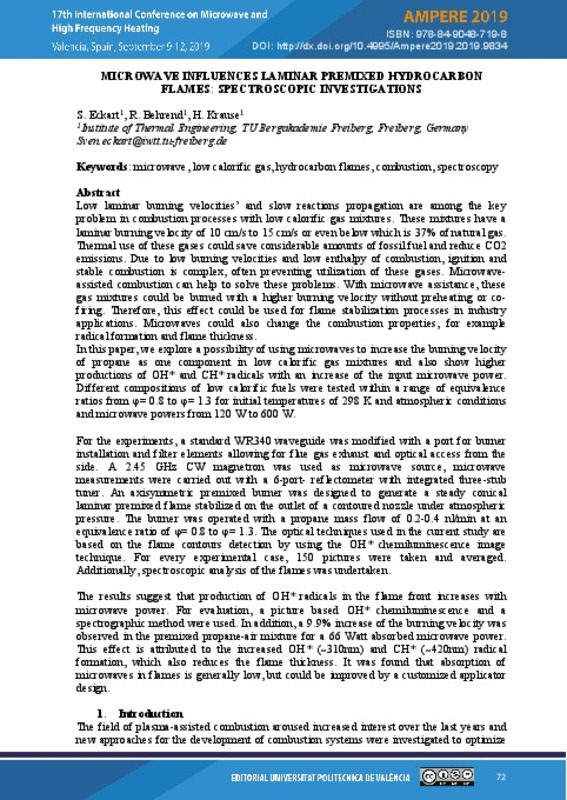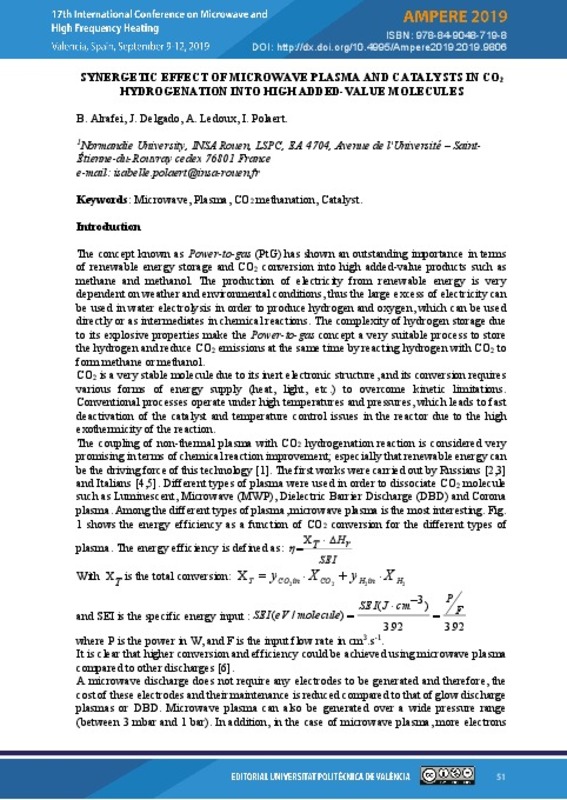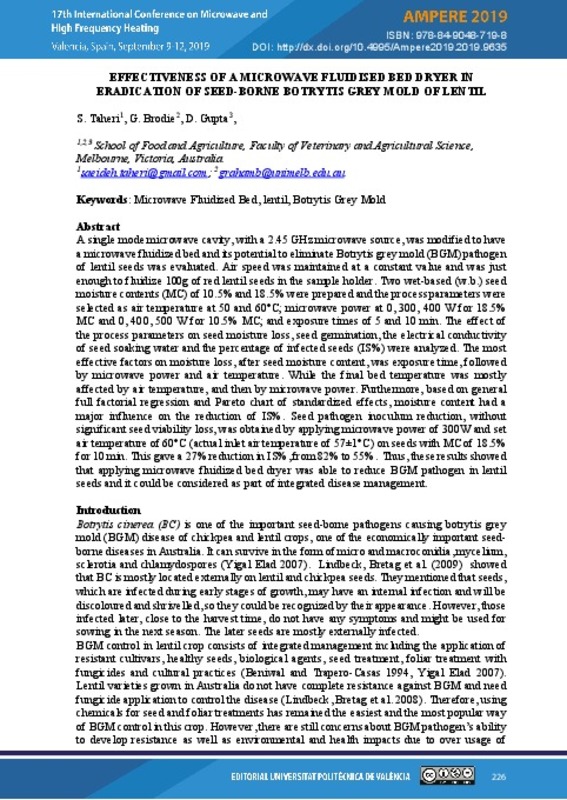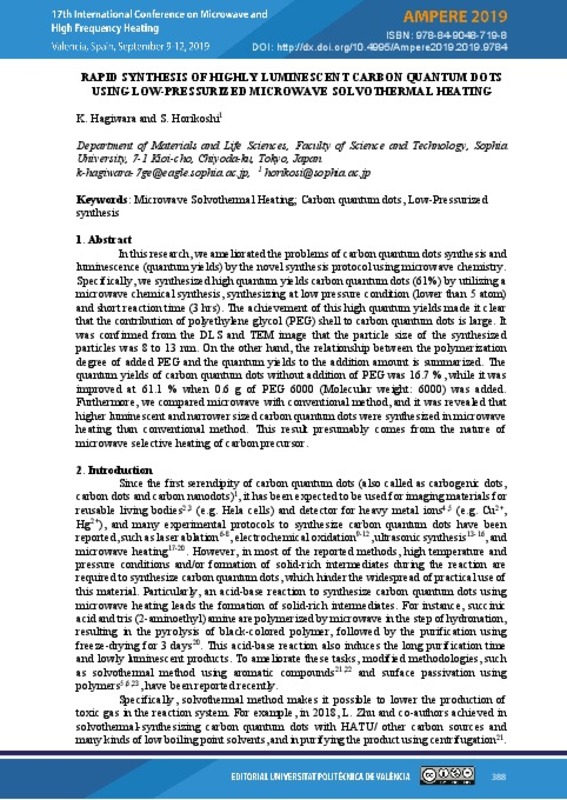JavaScript is disabled for your browser. Some features of this site may not work without it.
Buscar en RiuNet
Listar
Mi cuenta
Estadísticas
Ayuda RiuNet
Admin. UPV
Microwave influences laminar premixed hydrocarbon flames: Spectroscopic investigations
Mostrar el registro sencillo del ítem
Ficheros en el ítem
| dc.contributor.author | Eckart, Sven
|
es_ES |
| dc.contributor.author | Behrend, Ralph
|
es_ES |
| dc.contributor.author | Krause, Hartmut
|
es_ES |
| dc.date.accessioned | 2019-11-11T12:42:25Z | |
| dc.date.available | 2019-11-11T12:42:25Z | |
| dc.date.issued | 2019-10-15 | |
| dc.identifier.isbn | 9788490487198 | |
| dc.identifier.uri | http://hdl.handle.net/10251/130658 | |
| dc.description.abstract | [EN] Low laminar burning velocity’s and slow reactions propagation are among a key problem in combustion processes with low calorific gas mixtures. The mixtures have a laminar burning velocity of 10 cm/s to 15 cm/s or even below which is 37% of natural gas. Thermal use of these gases could save considerable amounts of fossil fuel and reduce CO2 emissions. Due to low burning velocities and low enthalpy of combustion, ignition and stable combustion is complex, often preventing utilization of these gases. Microwave-assisted combustion can help to solve these problems. With microwave assistance, these gas mixtures could be burned with a higher burning velocity without preheating or co-firing. Therefore, this effect could be used for flame stabilization processes in industry applications. Microwaves could also change the combustion properties, for example radical formation and flame thickness. In this paper, we explore a possibility of using microwaves to increase the burning velocity of propane as one component in low calorific gas mixtures and also show higher productions of OH* and CH* radicals with an increase of the input microwave power. Different compositions of low calorific fuels were tested within a range of equivalence ratios from φ= 0.8 to φ= 1.3 for initial temperatures of 298 K and atmospheric conditions and microwave powers from 120 W to 600 W. For the experiments, a standard WR340 waveguide was modified with a port for burner installation and filter elements allowing for flue gas exhaust and optical access from the side. A 2.45 GHz CW magnetron was used as microwave source, microwave measurements were carried out with a 6-port- reflectometer with integrated three stub tuner. An axisymmetric premixed burner was designed to generate a steady conical laminar premixed flame stabilized on the outlet of a contoured nozzle under atmospheric pressure. The burner was operated with a propane mass flow of 0.2-0.4 nl/min at an equivalence ratio of φ= 0.8 to φ= 1.3. The optical techniques used in the current study are based on the flame contours detection by using the OH* chemiluminescence image technique. For every experimental case, 150 pictures were taken and averaged. Additionally, spectroscopic analysis of the flames was undertaken. The results suggest that production of OH* radicals in the flame front increases with microwave power. For evaluation, a picture based OH* chemiluminescence and a spectrographic method was used. In addition, a 9.9% increase of the burning velocity was observed in the premixed propane-air mixture for a 66 Watt absorbed microwave power. This effect is attributed to the increased OH* (~310nm) and CH* (~420nm) radical formation, which also reduces the flame thickness. It was found that absorption of microwaves in flames is generally low, but could be improved by a customized applicator design. | es_ES |
| dc.description.sponsorship | The authors gratefully acknowledge the financial support by the European Union and the state of Saxony in the ESF project (project number 040606100). | es_ES |
| dc.format.extent | 9 | es_ES |
| dc.language | Inglés | es_ES |
| dc.publisher | Editorial Universitat Politècnica de València | es_ES |
| dc.relation.ispartof | AMPERE 2019. 17th International Conference on Microwave and High Frequency Heating | es_ES |
| dc.rights | Reconocimiento - No comercial - Sin obra derivada (by-nc-nd) | es_ES |
| dc.subject | Energy Production by Microwaves | es_ES |
| dc.subject | Microwave CVD | es_ES |
| dc.subject | EM Modelling | es_ES |
| dc.subject | Microwave Material interaction | es_ES |
| dc.subject | Dielectric Properties | es_ES |
| dc.subject | Dielectric Properties Measurement | es_ES |
| dc.subject | Solid State Microwave | es_ES |
| dc.subject | Microwave Processing | es_ES |
| dc.subject | Microwave Chemistry | es_ES |
| dc.subject | Microwave applicators design | es_ES |
| dc.title | Microwave influences laminar premixed hydrocarbon flames: Spectroscopic investigations | es_ES |
| dc.type | Capítulo de libro | es_ES |
| dc.type | Comunicación en congreso | es_ES |
| dc.identifier.doi | 10.4995/AMPERE2019.2019.9834 | |
| dc.relation.projectID | info:eu-repo/grantAgreement/Sächsische Staatskanzlei//040606100/ | es_ES |
| dc.rights.accessRights | Abierto | es_ES |
| dc.description.bibliographicCitation | Eckart, S.; Behrend, R.; Krause, H. (2019). Microwave influences laminar premixed hydrocarbon flames: Spectroscopic investigations. En AMPERE 2019. 17th International Conference on Microwave and High Frequency Heating. Editorial Universitat Politècnica de València. 72-80. https://doi.org/10.4995/AMPERE2019.2019.9834 | es_ES |
| dc.description.accrualMethod | OCS | es_ES |
| dc.relation.conferencename | Ampere 2019 | es_ES |
| dc.relation.conferencedate | Septiembre 09-12,2019 | es_ES |
| dc.relation.conferenceplace | Valencia, Spain | es_ES |
| dc.relation.publisherversion | http://ocs.editorial.upv.es/index.php/AMPERE2019/AMPERE2019/paper/view/9834 | es_ES |
| dc.description.upvformatpinicio | 72 | es_ES |
| dc.description.upvformatpfin | 80 | es_ES |
| dc.type.version | info:eu-repo/semantics/publishedVersion | es_ES |
| dc.relation.pasarela | OCS\9834 | es_ES |
| dc.contributor.funder | European Commission | |
| dc.contributor.funder | Sächsische Staatskanzlei, Alemania |
Este ítem aparece en la(s) siguiente(s) colección(ones)
-
Ampere 2019 [66]











